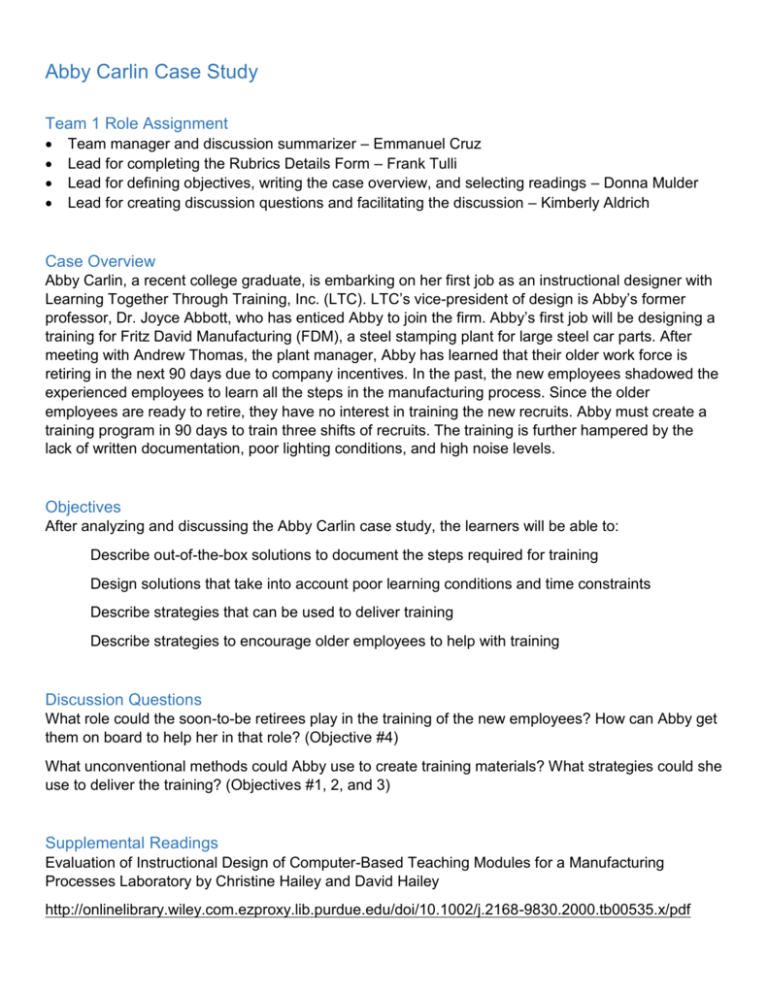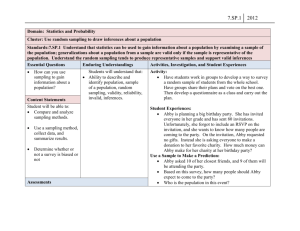After analyzing and discussing the Abby Carlin
advertisement

Abby Carlin Case Study Team 1 Role Assignment Team manager and discussion summarizer – Emmanuel Cruz Lead for completing the Rubrics Details Form – Frank Tulli Lead for defining objectives, writing the case overview, and selecting readings – Donna Mulder Lead for creating discussion questions and facilitating the discussion – Kimberly Aldrich Case Overview Abby Carlin, a recent college graduate, is embarking on her first job as an instructional designer with Learning Together Through Training, Inc. (LTC). LTC’s vice-president of design is Abby’s former professor, Dr. Joyce Abbott, who has enticed Abby to join the firm. Abby’s first job will be designing a training for Fritz David Manufacturing (FDM), a steel stamping plant for large steel car parts. After meeting with Andrew Thomas, the plant manager, Abby has learned that their older work force is retiring in the next 90 days due to company incentives. In the past, the new employees shadowed the experienced employees to learn all the steps in the manufacturing process. Since the older employees are ready to retire, they have no interest in training the new recruits. Abby must create a training program in 90 days to train three shifts of recruits. The training is further hampered by the lack of written documentation, poor lighting conditions, and high noise levels. Objectives After analyzing and discussing the Abby Carlin case study, the learners will be able to: Describe out-of-the-box solutions to document the steps required for training Design solutions that take into account poor learning conditions and time constraints Describe strategies that can be used to deliver training Describe strategies to encourage older employees to help with training Discussion Questions What role could the soon-to-be retirees play in the training of the new employees? How can Abby get them on board to help her in that role? (Objective #4) What unconventional methods could Abby use to create training materials? What strategies could she use to deliver the training? (Objectives #1, 2, and 3) Supplemental Readings Evaluation of Instructional Design of Computer-Based Teaching Modules for a Manufacturing Processes Laboratory by Christine Hailey and David Hailey http://onlinelibrary.wiley.com.ezproxy.lib.purdue.edu/doi/10.1002/j.2168-9830.2000.tb00535.x/pdf Boeing's got new teachers -- retirees http://www.oregonlive.com/business/index.ssf/2008/08/boeings_got_new_teachers_retir.html Older and wiser? : Workplace learning from the perspective of older employees by Alison Fuller and Lorna Unwin http://eprints.ioe.ac.uk/2347/ General Motors-Grand Rapids Stamping Operations https://www.youtube.com/watch?v=ixPhogfZTHU Stamping Plant Tour https://www.youtube.com/watch?v=ydoEJnwMlnk Rubric Details Form Team Members: Frank Tulli, Emmanuel Cruz, Donna Mulder, Kimberly Aldrich Name of Case: Abby Carlin – Documenting Processes in a Manufacturing Setting For each case, describe/address the following: Details for the Abby Carlin Case Study Who are the key stakeholders? Designer: Abby Carlin Client: Andrew Thomas SME: Big John Audience: New Operators Other important stakeholders: Dr. Abbott/LT3 What are the primary concerns of each stakeholder? Designer: Training everyone while keeping up production. Client: Time limited to 90-day design and implementation. Productivity should not be effected. SME: Retirement pending. Audience: Learning to use the Blanker machines. Other stakeholders: Abby’s performance is a reflection on the firm. What are the key (1-2) ID design challenges? (Hint: Label these as Analysis, Design, Development, Implementation or Evaluation.) 1. Analysis: Identifying the content to be taught. 2. Design: Determining the best methods for delivering the training. What case-specific constraints impact the designer’s ability to address design challenges? 1. Environmental Conditions ( noise, light) 2. Time 3. SME attitude How would you prioritize these design challenges and case-specific constraints? Why this order? 1st priority and why: SME attitude. The SMEs are key to the training. They are the only ones who can help Abby to learn the Blanker machine procedures. Without the SME’s knowledge, the project will fail. 2nd priority and why: Environmental Conditions. These can be adjusted for depending on the type of training that is created. Lesser priority challenges and why less important: Time and Analysis & Design issues. In order to execute the listed solutions, we need SME on board. Outline two reasonable solutions your classmates might suggest. Option 1 Have Abby approach Andrew about allowing “Big John” time away from the Blanker machine so that she can use him as an SME. Ask “Big John” or other current/former employees, to assist in training a new operator or several new operators by allowing the new operators to shadow the older ones. Work with Andrew to come up with incentives for current/former employees to train the new operators. Option 2 Record the operators at work with a GoPro camera. The video can be edited with captions and voiceovers added later. Abby can then create necessary training materials. Describe how each solution addresses the design challenges and case-specific constraints listed above. Option 1 Abby can learn and develop materials as she observes the SME’s actions. By convincing “Big John” to act as an SME Abby can remove him from the floor where conditions are less than optimal. This would make conversation easier when out of the poor floor conditions. Additional incentives would help bring past retirees in to help address the time issue. Option 2 Abby can learn and develop materials as she observes the video recordings. The video can be edited so noise is reduced and light is enhanced. Video eliminates direct contact with SME negating the effect of the negative attitudes of the SMEs. Discuss the pros for each solution. Option 1 Hands on training from SME for trainees. Immediate feedback from SMEs to trainees. Option 2 Not as many retirees needed to implement. Electronic based training can be accessed anywhere and anytime making training faster and more efficient. More cost efficient. Discuss the cons for each solution. Option 1 Need too many SMEs on board to make it work well. The training will be costly due to the inclusion of necessary incentives for the retirees. One-to-One training takes longer. Option 2 Specialized equipment needed for recording and editing video. Feedback from SMEs not immediate for trainees.



